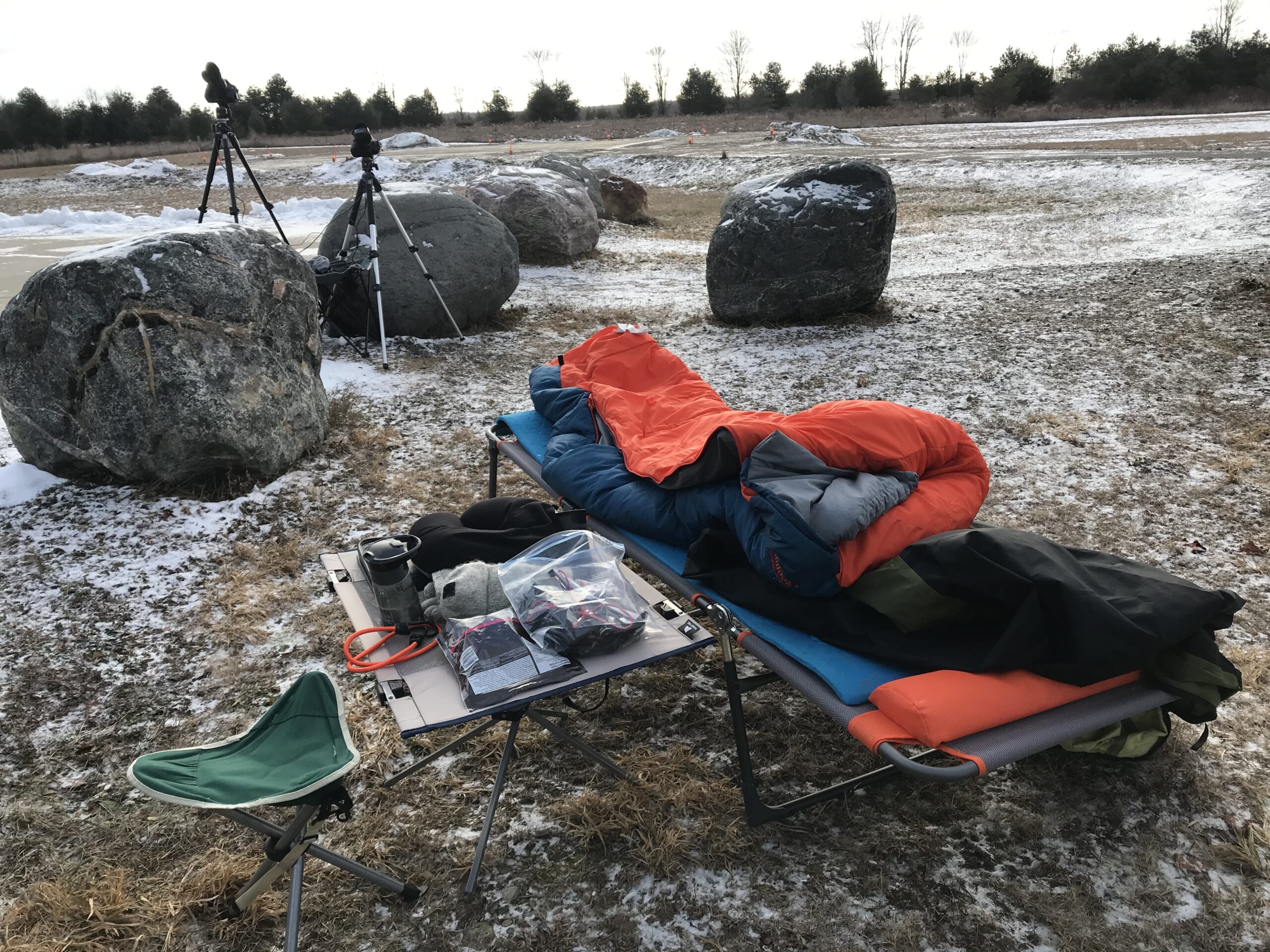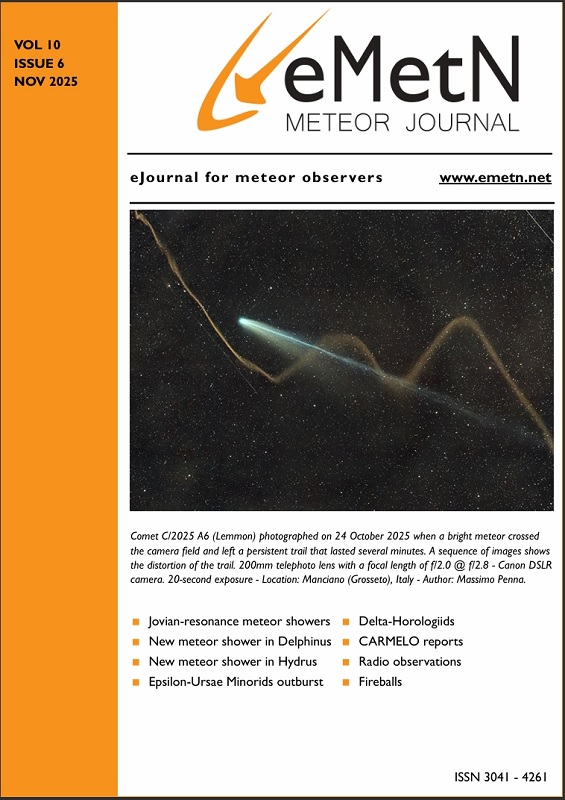The viewing conditions for the Geminids in 2020 were excellent, so local amateur astronomer/photographer Raymond Dubois and I intended to view them at a local dark site. Unfortunately, the peak night (December 13/14) was completely overcast, and had almost no hopes of clearing. We both made a last ditch attempt by meeting at a site about an hour’s drive east of Ottawa, in the hopes that we might get a hole. Unfortunately, it was solid clouds for a couple of hours, until we eventually gave up and returned home.
The following night was more promising with an early evening clearing trend to the south-west of Ottawa. After analyzing the weather, Raymond and I decided to go to the North Frontenac Dark Sky Preserve Site (NFDSP) near Plevna. I was the first one to arrive early in the evening, and Raymond arrived shortly after with his new truck. It was not too cold at -13C, but the gusts produced a -20C windchill so we bundled up well. Raymond and I setup our chairs behind the newly installed fencing (provided a nice wind blocking) while our cameras were out on the concrete pad. The fence also helps to block lights from other cars arriving into the parking lot area. I opted to keep it simple with my cameras by skipping the tracking and running them on fixed tripods, aimed at the same parts of the sky all night long. Some residual clouds were present early in the evening, around 9 pm local time, otherwise the sky transparency was average quality and the winter Milky Way was beautiful.
I signed on for a formal meteor watch just before 03UT Dec 15, and I observed for nearly 5 hours, until just after 07UT Dec 15 when the sky clouded over. I saw 72 meteors (35 Geminids, 7 Monocerotids, 6 December Leonis Minorids, 5 anthelions, 4 Comae Berenicids, 3 sigma Hydrids, one December Alpha Draconid and 11 sporadics). Geminids visual rates were below ten per hour but produced some fairly bright meteors up to mag -3. The most impressive meteor was a -4 blue-green Comae Berenicid that shot in Ursa Major and flared twice, leaving a ten seconds persistent train! The sky cleared up again before dawn, and I decided to do a bit of photography in other parts of the sky before going to sleep.
 Above: Composite image consisting of all the meteors captured during the night with a Canon 6D and a Rokinon 14mm f/2.8 lens. ISO 6400. 25 sec individual exposures. 1,306 images were taken between 01h11UT and 10h45UT on December 15 2021, of which 21 frames were found with meteors, that were added into this image. Two of the meteors may be Monocerorids and one may be a Sigma Hydrid. By Pierre Martin.
Above: Composite image consisting of all the meteors captured during the night with a Canon 6D and a Rokinon 14mm f/2.8 lens. ISO 6400. 25 sec individual exposures. 1,306 images were taken between 01h11UT and 10h45UT on December 15 2021, of which 21 frames were found with meteors, that were added into this image. Two of the meteors may be Monocerorids and one may be a Sigma Hydrid. By Pierre Martin.
 Above: Composite image consisting of all the meteors captured during the night with a Canon 5D and a Rokinon 24mm f/2.0 lens. ISO 3200. 20 sec individual exposures. 1,306 images were taken between 01h24UT and 07h56UT on December 15 2021, of which 7 frames were found with meteors, that were added into this image. By Pierre Martin.
Above: Composite image consisting of all the meteors captured during the night with a Canon 5D and a Rokinon 24mm f/2.0 lens. ISO 3200. 20 sec individual exposures. 1,306 images were taken between 01h24UT and 07h56UT on December 15 2021, of which 7 frames were found with meteors, that were added into this image. By Pierre Martin.
Here’s a link to the time lapse of a Geminid fireball persistent train created with Canon 5D and Rokinon 24mm f/2.0 lens, ISO 3200. 20 sec exposures (real time span is 10 minutes from 02h46UT to 02h56UT on December 15 2021):
Observation December 14/15 2020, 02:50-07:15 UT (21:50-02:15 EST)
Location: North Frontenac Dark Sky Preserve Site, Ontario, Canada
(Long: -76 deg 56’ 23” West; Lat: 44 deg 55′ 04″ North)
IMO session: https://www.imo.net/members/imo_vmdb/view?session_id=82752
Observed showers:
Southern chi Orionids (ORS) – 05:52 (088) +18
Anthelion (ANT) – 06:16 (094) +23
December Monocerotids (MON) – 06:49 (102) +08
Geminids (GEM) – 07:30 (112) +33
sigma Hydrids (HYD) – 08:36 (129) +02
December Leonis Minorids (DLM) – 10:20 (155) +34
Comae Berenicids (COM) – 11:24 (171) +20
December chi Virginids (XVI) – 12:40 (190) -10
December Sigma Virginids (DSV) – 13:16 (199) +07
December Alpha Draconids (DAD) – 13:46 (206) +56
02:50-03:50 UT (21:50-22:50 EST); 3/5 trans; F 1.00; LM 6.65; facing SE50 deg; teff 1.00 hr
GEM: seven: -1; +2(2); +3(2); +5(2)
MON: one: +4
Sporadics: two: +3(2)
Total meteors: Ten
03:50-04:50 UT (22:50-23:50 EST); 3/5 trans; F 1.00; LM 6.70; facing SE50 deg; teff 1.00 hr
GEM: nine: 0; +1; +2(4); +3; +4; +5
ANT: two: +2; +4
MON: one: +1
HYD: one: +4
DLM: one: +3
Sporadics: four: +3; +4(2); +5
Total meteors: Eighteen
04:50-05:50 UT (23:50-00:50 EST); 3/5 trans; F 1.00; LM 6.70; facing SE50 deg; teff 1.00 hr
GEM: nine: -3; +1; +2(2); +3; +4(4)
ANT: three: +1; +3; +5
MON: one: +3
HYD: one: +4
Sporadics: two: +3; +4
Total meteors: Sixteen
05:50-06:50 UT (00:50-01:50 EST); 3/5 trans; F 1.00; LM 6.70; facing SE50 deg; teff 1.00 hr
GEM: seven: +1; +2(4); +4; +5
COM: four: -4; +2; +3; +5
MON: three: +2(2); +4
DLM: three: +1; +4(2)
HYD: one: +4
Sporadics: two: 0; +4
Total meteors: Twenty
06:50-07:15 UT (01:50-02:15 EST); 3/5 trans; F 1.00; LM 6.70; facing SE50 deg; teff 0.42 hr
GEM: three: +3; +4; +5
DLM: two: +3; +4
MON: one: +3
DAD: one: +3
Sporadics: one: +3
Total meteors: Eight
Total meteors during this session: 72
 Above: Zodiacal Light with Canon 6D and Rokinon 14mm f/2.8 lens, ISO 6400. 25 sec exposure. By Pierre Martin.
Above: Zodiacal Light with Canon 6D and Rokinon 14mm f/2.8 lens, ISO 6400. 25 sec exposure. By Pierre Martin.










